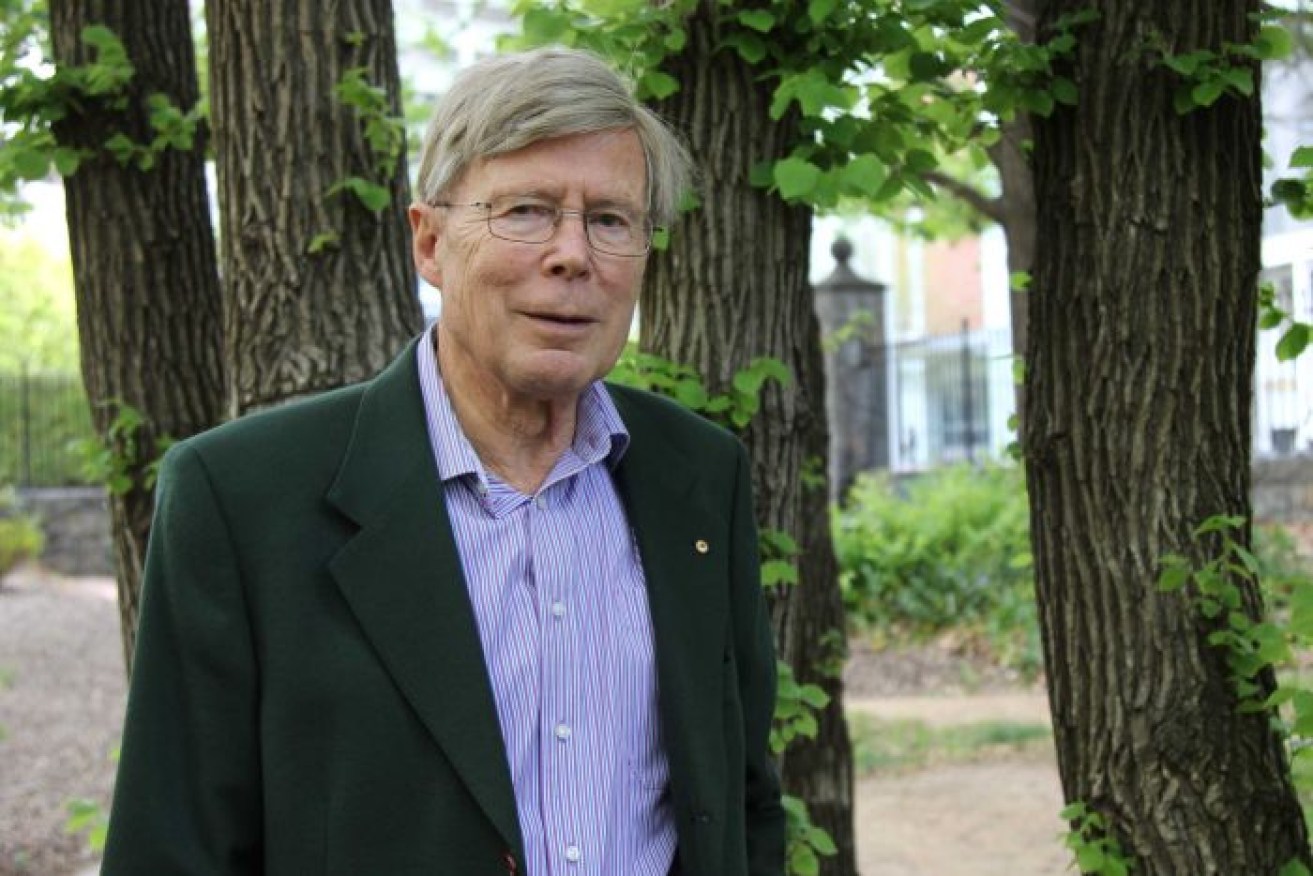Prime Minister’s science prizes go to those speeding up internet and keeping GPS accurate

Professor Kurt Lambeck is the winner of the 2018 Prime Minister's Prize for Science. Photo: ABC Science
A geophysicist whose work has helped plan space missions and paint a better picture of sea level rise has been awarded the 2018 Prime Minister’s Prize for Science.
Professor Kurt Lambeck received the $250,000 prize at Parliament House, for a huge body of research spanning a long and impressive career.
In the 1960s, his early work describing the Earth’s gravity field helped provide better planning for space missions.
“This was at the time when this whole satellite business started,” said Professor Lambeck from the Australian National University.
“It was a fairly obvious thing to do, to look at how these satellites could be used for mapping … and then of course all these interesting geophysical results came out. And I think at that point I became a true scientist, rather than an engineer.
“I switched really from being a space technologist to a geophysicist.”
As he looked deeper it became apparent that changes in the Earth’s gravity field were connected to plate tectonics – the movements of continents on the Earth’s surface.
The next phase of his research helped explain how our planet changes shape over time, which has implications for sea levels, the movement of continents and even the orbits of satellites.
“There’s a whole spectrum of variations that go from seconds, to the age of the Earth.”
Professor Lambeck set about trying to understand what that spectrum of variation looked like.
Studying the Earth’s ice ages helped do this, while contributing to our understanding of sea level rise from global warming.
“The glacial story is one of the elements in that spectrum,” he said.
“Antarctic-sized ice sheets [once] sat over North America for example, and over Asia. And the Earth cannot support the sort of loads that are associated, so it sags underneath and the crust subsides.”
When the ice sheets melted, the Earth’s crust began to rise again – very, very slowly, in processes that continue today.
Over time the position of the land changed relative to the sea. Some of that may be due to the Earth’s crust rising, while some of it may be due to ocean volumes changing.
“That’s the key contribution that we are bringing to this.”
It’s research that has helped shape discussions about sea level rise caused by global warming.
“If the remaining ice sheets melt in Greenland and Antarctica, sea levels are going to go up again, so what we are doing is providing the framework for discussing that,” he said.
“Satellites have been built to measure these current deformations, particularly to see what’s happening to Greenland and Antarctica – however those signals are contaminated by what happened in the past [for example glacial rebound from the ice ages].
“We can provide the mechanisms to strip that off and see what’s happening today, and how much of what’s happening today is due to melting of the ice sheets or warming of the oceans.”
Ensuring the accuracy of GPS-based apps
Professor Lambeck’s research has also helped inform the GPS systems we rely on for smartphone navigation apps, high-tech mining activities – and for precision farming.
“Farming is increasingly done by semi-automation,” he explained.
“Tractors are equipped with GPS receivers so that they can repeat exactly the same ploughing tracks each year, but the surface of the Earth is shifting underneath the satellites.
“Each year in Australia, your track is going to be displaced by something like seven or eight centimetres, and that’s damaging for the soil.”
The shifting of the Earth has similar implication for the accuracy of GPS systems that might one day control driverless cars.
And when you’re relying on GPS systems to inform a vehicle travelling at over 100 kilometres per hour, access to accurate data can be a matter of life or death.
“That’s really created the need for a very, very precise referencing system, whereby we know where every point on the Australian continent is, or in the world in fact, at sub-centimetre accuracy,” he said.
“And that’s what’s been developed in Australia over the last decade.”
Professor Lambeck helped create a network of about 100 GPS stations, radio telescopes and laser tracking systems that allows for location tracking with this kind of accuracy across Australia.
“My role in that has been essentially not to do the hard computational work, but to drive that program along,” he said.
Professor Lambeck, who has already tried to retire once, said the prize would help him continue his research “for a few more years”.
He said government support for science was “absolutely essential” in order to develop the national ability to provide evidence-based facts to support their policies.
“When you look [at the other awardees] … you’ve got some very bright people here who’ve done wonderful things both in the applied areas and the basic science areas.”
Boosting internet speed and capacity
The second major award was presented to four Australian scientists and engineers, whose company has helped revolutionise the speed and capacity of the internet.
Andrew Bartos, Dr Simon Poole, Dr Glenn Baxter and Dr Steven Frisken of Finisar were awarded the $250,000 Prime Minister’s Prize for Innovation, for creating a device through which about half the world’s internet traffic now travels.

The Finisar team, Andrew Bartos, Glenn Baxter, Simon Poole and Steven Frisken, are the winners of the 2018 Prime Minister’s Prize for Innovation. Photo: ABC Science
A lot of people don’t realise, Mr Bartos said, the internet and mobile telephones predominantly run on optical fibre.
“It’s been like that for many years – but it was clear to us around about the year 2000 that the fibre, and the light in the fibre, wasn’t being used efficiently enough,” he said.
Mr Bartos and his colleagues realised if light could be more efficiently used in the fibre, and more efficiently switched, there was potential for big improvements in speed and capacity.
The result was a light-bending switch – using prisms, liquid crystals and silicon – with the capacity to process a million high-definition streaming videos at once.
“We did have a challenge to convince people that our approach was worthwhile,” Mr Bartos said.
“But in about the last four or five years, it’s become the dominant technology in the industry and now it’s unquestioned.”
The technology has also played a role in helping people in less-developed countries access high-speed internet, which would previously have been affordable.
“That’s one of the nice things … in a way, it’s democratising, or spreading the availability of the internet,” Mr Bartos said.
“We’re really pleased to have both benefited the developed and less-developed world because there’s not that many technologies that everyone gets access to.”
Full list of winners
- Prime Minister’s Prize for Science ($250,000) – Professor Kurt Lambeck AO, for transforming our understanding of our living planet.
- Prime Minister’s Prize for Innovation ($250,000) – The Finisar team, for creating and commercialising technologies that underpin the global internet.
- Frank Fenner Prize for Life Scientist of the Year ($50,000) – Dr Lee Berger, for work to save frogs, and reveal new extinction threats.
- Malcolm McIntosh Prize for Physical Scientist of the Year ($50,000) – Associate Professor Jack Clegg, for creating flexible crystals and new separation technologies.
- Prize for New Innovators ($50,000) – Dr Geoff Rogers, for his steerable guidewire to improve the treatment of heart disease.
- Prime Minister’s Prize for Excellence in Science Teaching in Primary Schools ($50,000) – Brett Crawford, for creating an environment in which every teacher is engaged in science at his school.
- Prime Minister’s Prize for Excellence in Teaching in Secondary Schools ($50,000) – Dr Scott Sleap, for creating the Cessnock Academy of STEM Excellence.
–ABC








